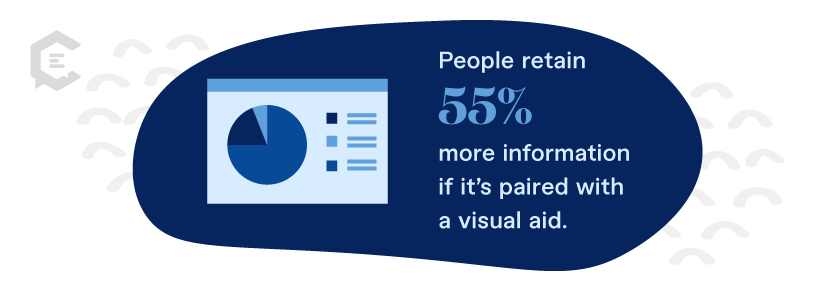How are your pitching skills?
The art of pitch strategy has evolved into a dual skill set. You have to be able to hold people’s focus through a screen and command a room’s attention. But those two things don’t necessarily require the same technique, and navigating both arenas can be challenging.
In this comprehensive guide, we’ll cover the best practices for pitching in both video and in-person conference settings. Then, we’ll discuss some common pitfalls and how to avoid them.
Universal Best Practices for Networking
A lot of content marketers have a love/hate relationship with networking. Sometimes, there’s nothing more uncomfortable than a room full of strangers. And it’s easier than ever to coast doing the bare minimum.
But as virtual networking has become more ubiquitous, fostering meaningful, personal connections with colleagues in your industry is more essential than ever. So, let’s talk about ways you can walk into your networking situations confident and ready to rock, virtual or in-person, ready to pitch with confidence.
Come prepared
It may sound simple, but preparation can take care of those pre-networking jitters. Be proactive if you know you’ll be uncomfortable. Those nerves often come from a lack of information: not knowing what you’re going to talk about.
Next time you’re attending an event, ask yourself beforehand: “What do I want out of this and why?” Set specific goals in your mind that will keep you focused. Maybe you’re a software start-up wanting to walk out at the night’s end with ten new leads. Perhaps you want to start small and make one meaningful connection that results in setting a follow-up meeting.
Do some research on who will be there. The more comfortable you can make yourself ahead of time, the more relaxed you’ll be at the event and the easier the conversation will be.
Ask people about themselves
Speaking of conversation, when in doubt, talk to people about themselves. Have some conversation starters ready before you walk in. It’ll make getting over those initial nerves easier. Here are a few simple but solid examples:
- How’s your night going?
- What do you think of the event so far?
- What did you think about the speaker?
And don’t sleep on talking about that food spread.
When in doubt, focus on the other person. It’s easy to obsess over ourselves and forget about the person we’re talking to. Asking someone about themselves and being genuinely interested can do more for your networking than any prepared talking point.
Write notes after your conversations
Alright, you used your conversation starters and active listening to have some great conversations. The last thing you want is to wake up the next day, having forgotten half of it.
Pro tip: at the end of the night, write down a few sentences on each meaningful interaction you had. Write down their name, job, company, and bullet points on what you talked about. It’ll increase your retention and provide a reference when you follow up. Plus, recalling specific conversation points with a potential prospect will go a long way in fostering a strong relationship.
Always Follow Up
Your networking doesn’t stop at the event. Building meaningful connections requires following up. But how do you follow up effectively?
Send an email or LinkedIn message within the first day or two of meeting someone. You want to reach out when the interaction is still fresh in people’s minds. Reference a specific moment in your conversation with them (this is where those notes will come in handy). Think of a way you can offer to help them and ask to set up a one-on-one.
Video Conference Pitching Best Practices
Get as much information as you can
When you’re doing a video conference, preparing can feel tough when coordinators wait to share conference details until the last minute. Be proactive about reaching out to get as many details as possible ahead of time. There’s usually a designated coordinator whose job is to help facilitate logistics.
And don’t just ask for the login details. Try to get as much intel as possible. See if any questions or discussion topics are available. If you’re giving a pitch, try to find out what the prospect is interested in seeing. Ask if there are materials you can send to prepare the attendees beforehand.
Finally, find out if they plan to record any part of the video conference. You’ll want to rehearse those particular discussion points even more if they are.
Prep your environment
Your environment and tools can mean the difference between success and failure. First, make sure you have a strong Wi-Fi connection. The last thing you want is for your connection to drop during your pitch meeting. Double-check your internet speed on Google Fiber to ensure your connection is stable and reliable.
Have your video conference software and tools set up in advance. Consider an upgrade if you’re just using a laptop and a built-in microphone. Lights and an external microphone or webcam can significantly enhance your sound and visuals, and greatly improve your first impression.
When you’re pitching at a content marketing conference, you want the attendees to focus on you, not what’s in the frame behind you. Use a neutral background that doesn’t pull focus or a virtual background through the video conference platform. Just don’t put yourself on the beach or in space. It’s also best if your set-up is somewhere that has the least amount of ambient noise.
Finally, make sure you’re not interrupted. Put up a do not disturb sign, close your door, lock it, and turn off your phone. And don’t forget to turn off Alexa or other smart home devices that may choose an inopportune moment to join the conversation.
Run a tech rehearsal
Even if you’ve set everything up and recently used it, do a tech run-through right before the call. You might catch a surprise hiccup or two, like your video conference software needing an update or your microphone accidentally being disconnected.
Check that the audio input and output are set properly, which is particularly important if you’re using headphones or an external mic. Close extra windows and apps running on your computer is equally important. Double-check that Spotify, Google Drive, and other programs you may have continuously running in the background are shut down for this occasion; otherwise, they can suck your bandwidth.
It also doesn’t hurt to do a full run-through of your pitch while you’re doing the tech rehearsal. The more you practice with all the elements you’re using, the more polished you’ll be on the video call. Treat the rehearsal like a live run-through and see if any issues arise. Knowing that everything is firing on all cylinders will make you even more confident going into your pitch.
Speak for and to the camera
Before a pitch, your energy will most likely be higher than normal due to nerves or excitement. Make sure you don’t start the pitch too loud and too fast. Breathe and focus on speaking a bit slower than usual. Look into the camera and engage the other attendees with a conversational tone that draws them in. Looking into the camera, it can initially feel weird when everyone is on the screen below. But having your eyes look into the camera will establish a stronger connection with the people watching than looking down on your screen. Also, pause at appropriate moments and ask if anyone has questions or wants more details on what you just said.
And if any issues come up, use them as an opportunity to let yourself shine. Staying relaxed and troubleshooting challenges smoothly can be more valuable than the actual information you’re pitching. You’ll showcase an ability to be cool under pressure that makes you valuable to work with.
In-Person Pitching Best Practices
Rehearse, rehearse, rehearse
With video conference pitching, relying on notes or cues outside your screen’s frame is easy. But in-person pitching is a different animal. It requires complete mastery of your material. Practice your pitch repeatedly to lock down its timing and flow.
If you can, rehearse in the actual room or venue to get a feel for the environment. If you have any visual aids, use them while rehearsing to ensure a smooth and effective transition. That mastery will convey two things: confidence and relaxation.
Speaking of confidence and relaxation, one of the most essential aspects of any in-person pitch is your physical presence. Unlike video conferencing, in-person pitching lets you connect directly to your audience. Use every aspect of that to your advantage. Make sure you dress the part to set the tone before speaking. Use your body language and voice modulation to reinforce what you’re saying and command the room you’re in. They’re both ways to subconsciously communicate to your audience that you’re confident and relaxed, which will capture their attention.
Engage through storytelling
Storytelling beats statistics. Take your audience on an emotional journey that speaks to their needs and pain points. Incorporate real-life anecdotes or short narratives to support the information you’re presenting. The more you incorporate storytelling elements, the more relatable and memorable your pitch will be.
Also, unlike virtual conferences, in-person settings offer immediate feedback. If something’s not resonating, you can feel it in the audience. Stay flexible and adapt your pitch on the fly if you need to re-engage your audience.
Leverage visual aids
Your spoken words are the foundation of your pitch. But never underestimate the power of compelling visual aids. Whether a pitch deck presentation or a live demo, visuals can enhance your message by speaking to people’s visual learning. On average, people retain 55% more information if it’s paired with a visual aid. That means your message becomes that much more memorable. Remember to practice using your aids while you rehearse to ensure a smooth flow in your presentation. And don’t overload your pitch with visuals. A little goes a long way.
Manage your time
The last thing you want is to run out of time or rush through your closing points. How you finish is one of the most important aspects of any pitch, in-person or virtual. But you don’t have to worry, because you’re rehearsing! And when you do, you’re practicing to ensure you can deliver your whole pitch within the allotted time. Just remember to leave enough time for a Q&A. Leaving room for questions means leaving room for a conversation that increases audience engagement and answers the question someone needs to get hooked.
Common Pitfalls to Avoid When Pitching at Marketing Conferences
Not knowing your audience
It sounds simple, but many presenters can get so caught up in the substance of what they’re pitching that they forget about the audience they’re speaking to. Before you craft your pitch, make sure to research your audience. Who are they? What are their objectives for this conference? How can you tailor your pitch’s messaging to engage their expectations and pain points? Knowing your audience sets you up to craft the most compelling pitch that speaks to their needs and demonstrates your value.
Overloading information
There’s a fine line between being comprehensive and cramming too much information into your pitch. You don’t want to leave your audience struggling to keep up. Less can often be more. Concentrate on your key messaging that aligns with your audience’s needs and expertly weave in information to support it. A focused, streamlined presentation is more effective than a jam-packed one.
Technical glitches
We covered this up above, but we’re going to repeat it. There’s no faster way to lose your audience than technical malfunctions. Always run multiple checks on every aspect of the tech you’re using: software, hardware, and internet (if applicable). And that’s not limited to video conference pitches. A lot of in-person pitches have tech as well. Don’t let a technical issue be why your pitch isn’t successful.
Not leaving time for questions
Many presenters focus so much on the pitch that they forget the questions afterward. You should always build in time to answer any questions from your audience. A solid presentation can be ruined by not being prepared for questions or forgetting to leave time for a Q&A. It also helps to do your homework beforehand, anticipate the most likely questions, and polish your answers.
Feeling Ready to Pitch at Content Marketing Conferences?
Having the proper technique for your pitching strategy is essential to your success. Effectively pitching is just one of the skills every content marketer needs. If you’re looking to level up not just you’re pitching but also your content strategy, ClearVoice has you covered. Talk to a content specialist today, and we’ll help you craft top-tier, airtight strategies that drive your success.









